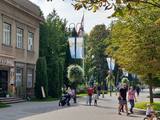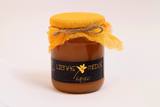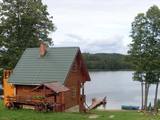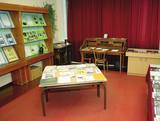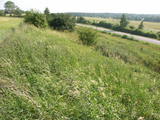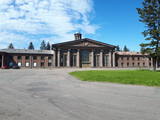| Nr | Nosaukums | Apraksts |
|---|---|---|
|
The farm on the banks of the River Navesti is Estonia's largest company engaged in the cultivation and processing of organic medicinal herbs. The farm has an education and health path of medicinal herbs, open from May to September. Farm has a tea house completed in 2010 which is suitable for holding seminars, relaxing and in the summertime also for having meals. Herb presentations are held there - first on the field and then in the tea house. There is also a 13-metre viewing tower by the river from which you can get a good overview of the lands of the farm. Energy Farm also offers accomodation and Eco-Spa with sauna. |
||
|
1699. g. Ņukšu centrā Pasienes dominikāņu mūki uzcēla kapliču, kuras vietā 1765. g. muižnieks Hilzens uzbūvēja jaunu baznīcu. Telpām kļūstot par mazu, 1922. - 1926. g. uz vecās baznīcas pamatiem uzcēla jaunu un lielāku – tagadējo Pildas katoļu baznīcu, ko dēvē par vienu no skaistākajiem Latgales koka dievnamiem. Ēkā atrodas 18. gs. otrajā ceturksnī darināts centrālais altāris un divi sānu altāri, kas tapuši ap 1700. g. Baznīcu var apskatīt arī no iekšpuses. |
||
|
Saimniece jūs sagaidīs ar mazu stāstījumu par saimniecību, veselīgu zāļu tēju un pašceptiem gardumiem. Ja ir vēlme nakšņot zem klajas debess, piedāvā telšu un ugunskura vietas, kuras atrodas upes krastā pie vecām Lūku dzirnavām. Zemnieku saimniecība “Aploki” gaida ciemos ikkatru, kas vēlas atpūsties klusā un mierīgā gaisotnē. |
||
|
Suhka saimniecībā ievēro senās tradīcijas un pasniedz vietējo ēdienu. Piedāvā arī naktsmītni, kas atrodas gleznainā vietā. Turklāt šeit iespējams uzzināt pārgājienu maršrutus pa vietām, kuras paši neatradīsiet. |
||
|
Arheoloģisko izrakumu materiāli liecina, ka Ogres upes krastus ir apdzīvojuši lībieši. Ogre, kā lielāka apdzīvota vieta un nozīmīgs kūrorts, izveidojās pēc Rīgas-Daugavpils dzelzceļa izbūves 1861. g. Līdz 1. pasaules karam Ogrē savus pakalpojumus piedāvāja ~ 300 vasarnīcas, kas kara laikā g.k. tika nopostītas. Nākamais „liela mēroga" notikums norisinājās 1965. g., kad Ogrē uzcēla vienu no Eiropā lielākajiem trikotāžas kombinātiem, kurā strādāja viesstrādnieki no Vjetnamas u.c. valstīm. Mūsdienās Ogre savu kūrorta slavu vēl joprojām nav atguvusi, bet gan kļuvusi par samērā ekskluzīvu g.k. mazstāvu privātmāju apbūves vietu. |
||
|
Mākslinieces darbnīca atrodas ļoti skaistā viensētā. Auž gobolēnus un piedāvā vērot darbu tapšanas gaitu, pasūtīt, kā arī iegādāties gatavos izstrādājumus. Daudzi no tiem ir praktiski suvenīri un izmantojami kā labas dāvanas. |
||
|
Piedāvā dažādziedu, meža, viršu, liepziedu, ziedputekšņu, bišu maizes, propolisa u.c. biškopības produktu iegādi. Dalās pieredzē un izrāda piemājas dravu. |
||
|
The smoke sauna is an important part of everyday life in the Võru community in Estonia. It is the centre of a rich set of traditions including the actual bathing customs, the skills of making bathing whisks, building and repairing saunas, and smoking meat in the sauna. The sauna is a building or room heated by a stove covered with stones and with an elevated platform for sitting or lying. It has no chimney, and the smoke from the burning wood circulates in the room. People usually go into the sauna together and remain until they are sweating. Water is thrown on the heated stones to produce hot steam-laden air and bathers beat their bodies with whisks to remove dead skin and stimulate blood circulation. After sweating, whisking, relaxing and possible healing procedures, people cool themselves outside and rinse their bodies with water. The procedure is then repeated. The smoke sauna tradition is primarily a family custom, usually practised on Saturdays, but also before major festivals or family events. Its main function is to relax the body and mind. Families take turns hosting each other. Usually an older family member is responsible for preparing the sauna, accompanied by the children who gradually acquire the necessary skills. The smoke sauna tradition is part of the UNESCO Representative List of the Intangible Cultural Heritage of Humanity. |
||
|
Vienīgā šāda veida skatu platforma - celta ziemeļos no Pāvilostas – starp jūras krastu un Latvijas lielāko pelēko kāpu. No otrā stāva labi pārskatāmi pelēkās kāpas biotopi, jūras krasts, lielākais Baltijas jūras piekrastes akmens – Pāvilostas jūrakmens, Pāvilostas ziemeļdaļa, bet vējainā laikā – kaitbordistu meistarstiķi.
|
||
|
Līdzmūsdienām ir saglabājusies vecā - 18. gs. vidū klasicisma stilā celtā vecā kungu māja (šobrīd netiek izmantota, skaisti sīkrūšu logi!) un tai iepretim - pēc 1905. g. ugunsgrēka atjaunotā (1912. – 1913. g., neoklasicisma stils) jaunā pils, kurā atrodas Īvandes pagasta pārvalde, bibliotēka un jauniešu tūristu mītne. Ēkā saglabājušies atsevišķi interjera elementi – parketa grīdas, koka kāpnes u.c. Muižas parkā joprojām zaļo Baltijā lielākā Eiropas baltegle. Tās augstums pārsniedz 32 m, apkārtmērs - 4 m. Parkā izveidota atpūtas vieta. |
||
|
Celta kā cietokšņa tipa ēka. Cietusi Livonijas un Ziemeļu kara laikā. 1865. g. tapis mūsdienās redzamais tornis. J. V. Rabes darinātā kancele ar vītņkāpnēm. |
||
|
Sertificēta bioloģiskā saimniecība (ģimenes uzņēmums) ar 2 nozarēm: biškopība un dāzkopība. Tiek ražoti biškopības produkti: dažādu veidu medus un medus maisījumi ar tējām un garšvielām kā arī zaļumi, dārzeņi, āboli. iespējams arī apskatīt saimniecību. |
||
|
Lauku māja atrodas Alksnis ezera krastā Aukštaitijas nacionālajā parkā. Ezers ir savienots ar pārējiem ezeriem, kas iekļaujas šinī parkā. Šī vieta ļoti piemērota makšķerniekiem un tiem, kuriem patīk baudīt mieru. Plaša viesistaba ar kamīnu, 2 guļamistabas, atsevišķs pirts namiņš, vieta ugunskuram, laivas nomai. |
||
|
Bērzgales novadpētniecības muzejs dibināts 1988. gadā. Tajā
iekārtota rakstnieka Antona Rupaiņa (1906 – 1976) piemiņas istaba,
ekspozīcija par pagasta vēsturi, tā ievērojamiem cilvēkiem un
kultūrvēsturiskajām tradīcijām.
Darba laiks: P. - Piekt: 9.00 – 12.00,13.00 – 17.00, S., Sv : pēc pieteikuma |
||
|
Ģimenes restorāns “Pie Māmiņas” atrodas pie Mellužu estrādes Jūrmalā, 27km no Rīgas. Šeit bērni var aizrauties ar zīmēšanu un spēlēties rotaļu stūrītī, savukārt vecāki – baudīt maltīti nepiespiestā gaisotnē. Eiropas un Latvijas virtuves piedāvājums visām ēdienreizēm, dienas zupas, salāti, pamatēdieni, desertu izase un mājīga atmosfēra. |
||
|
Atrodas Rīgas ielā 22 a. Ēka ar iespaidīgo būvapjomu celta pēc Valsts prezidenta Kārļa Ulmaņa ierosmes 1936. - 1937. gadā (arhitekts Verners Vitands) un nominēta kā viens no Latvijas pirmās brīvvalsts izcilākajiem arhitektūras pieminekļiem. Atrodamas ziņas, ka celtne pat bijusi modernākā daudzfunkcionālā ēka Eiropā! Tagad Vienības namā darbojas Daugavpils teātris, Latgales centrālā bibliotēka, Latviešu kultūras centrs, Latviešu māja, ASV informācijas centrs, Daugavpils TIC u.c. iestādes. Blakus namam atrodas Vienības laukums. Sezonas laikā tuvākajā apkārtnē izveidotas skaistas ziedu kompozīcijas. |
||
|
Dabas takā gar Rojas upi iespējamas 3 dažāda garuma distances, kas lokveidā ved gar upi un tai pieguļošajiem mežiem – 2 km, 7 km un 15 km, kas katra atzīmēta ar savas krāsas norādēm. Dzeltenais aplis 2 km, zilais aplis – 7 km, sarkanais aplis – 15 km. Maršrutus var veikt arī ar velosipēdu, taču braucot ar velo, atsevišķi posmi var būt grūti izbraucami smilšu dēļ. Pie upes ierīkotas vairākas atpūtas vietas ar soliem, galdiem, labierīcībām, šūpolēm, vingrošanas konstrukcijām, atkritumu urnām, kā arī ugunskura un telšu vietām. Pie atpūtas vietām Žocenē un Rojā ir izveidotas arī laivu piestātnes. Takas sākumā upes krastā labiekārtota vieta, kur upē ietek Rojas avots, ko kā ūdensņemšanas vietu iecienījuši vietējie iedzīvotāji. |
||
|
Teritorija veidota izteiktās Baltijas ledus ezera senkrasta kāples aizsardzībai, kuras izteiktākais posms stiepjas līdztekus Grobiņas – Ventspils šosejai vairāk nekā 10 kilometru garumā (ceļa austrumu pusē). Kaut arī no senkrasta augšpuses paveras plašs skats uz Piejūras zemienes ainavu, diemžēl, šobrīd nav izveidota neviena labiekārtota skatu vieta, kā arī atbilstoša informācija. Teritorijā sastopamas aizsargājamas augu sugas un biotopi. |
||
|
Spilves pļavas tika izmantotas kara aviācijas vajadzībām jau 1. Pasaules kara laikā. 1922. gadā bumbu sabojātā lidlauka atjaunošanu veica Latvijas Republikas Aviācijas divizions Jāzepa Baško vadībā. Drīz pēc tam Spilvē 51 hektāru lielā teritorijā pie Rīgas - Bolderājas dzelzceļa atzara un šosejas iekārtoja arī civilo lidostu, kuru no Rīgas pilsētas nomāja Latvijas Pasta un telegrāfa departaments. |
||
|
Sēlijā, pie Slates sila, atrodas "Kalnaleiskini". Saimnieks Mārtiņš Uzkurs ir galdnieks, bet sieva Lelde - dizainere abu kopējā galdniecības uzņēmumā un Latvijas Ornitoloģijas biedrības biedre ar pieredzi ekskursiju vadīšanā. |
||





